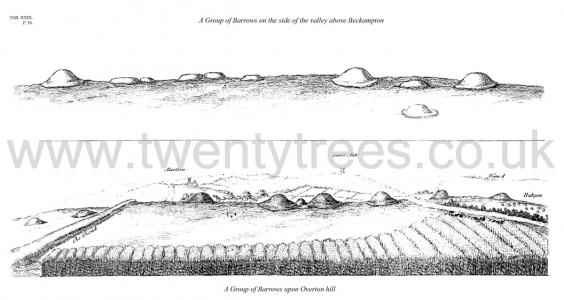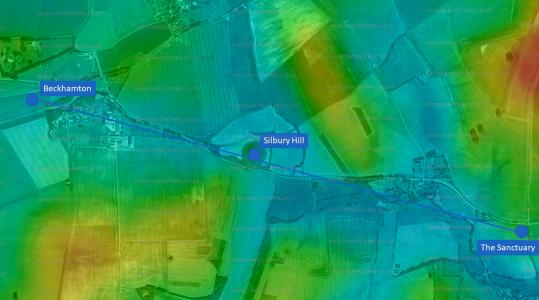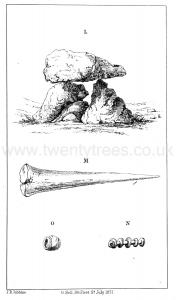Europe, British Isles, South-West England, Wiltshire, Beckhampton [Map]
Beckhampton, Wiltshire is in Wiltshire.
Avebury by William Stukeley. Table XXIX. Top: A Group of Barrows on the side of the valley above Beckampton [Map]. Bottom: A Group of Barrows upon Overton hill [Map].

Avebury by William Stukeley. In Bekamton town [Map], near the termination of Bekamton avenue, or the snake's tail, is such another place, called Old Chapel or Chapel field. 'Tis full of great stones, many buried under-ground. Richard Fowler, that great depopulator, told me, he demolished one stone standing near the hedge of the pasture. Near it a great stone lies upon the mouth of an old well, as they say, but never remember that it was open, only speak by tradition. This field belongs still to the church.
Europe, British Isles, South-West England, Wiltshire, Beckhampton, Long Stones Long Barrow [Map]
Long Stones Long Barrow is also in Avebury Long Barrows North.
Long Stones Long Barrow [Map]. Historic England:
The monument includes a Neolithic Long Barrow aligned north east to south west and situated on a gentle east-facing slope, 300m south west of the South Street long barrow [Map].The barrow mound has been slightly disturbed by cultivation in the past but survives as an impressive earthwork which measures 84m long and 35m wide. The mound stands up to 6m high and is flanked to the north and south by quarry ditches which provided material for the construction of the mound. These have become partially infilled over the years owing to cultivation but survive as slight earthworks c.24m wide and 84m long with a depth of c.0.6m. The barrow was partially excavated by Merewether between 1820 and 1850. He discovered evidence of a Bronze Age cremation burial contained in a 'Deverel Rimbury' style pottery urn and a piece of bronze which was probably part of a dagger. The urn is now located in the [Map].
Avebury by William Stukeley. A little way hence is a bit of heath-ground, but the plough will soon have devoured it. Here remains a great barrow, called Longstone long barrow [Map] ; and from hence we see innumerable more barrows. The avenue continued its journey by the corn fields. Three stones lie still by the field-road coming from South-street to the Caln-road. Mr. Alexander told me he remembered several stones standing by the parting of the roads under Bekamton, demolished by Richard Fowler. Then it descends by the road to Cherill, 'till it comes to the Bath-road, close by the Roman-road, and there in the low valley it terminates, near a fine group of barrows, under Cherill-hill, in the way to Oldbury-camp; this is west of Bekamton-village. This point facing that group of barrows and looking up the hill is a most solemn and awful place; a descent all the way from Longstone cove, and directed to a descent, a great way further, down the Bath-road, where no less than five valleys meet. And in this very point only you can see the temple [Map] on Overton-hill, on the south side of Silbury-hill [Map].
Avebury by William Stukeley. There are likewise about Abury some pyriform barrows, longish, but broad at one end: some composed of earth, thrown into a tumulus. Of this sort a very long one in the valley from Bekamton to Runway-hill. Another among the furze bushes south of Silbury, set with stones, which farmer Green carryed away. Others made of stones set upright in that form. Of the latter, a very large one in Monkton-fields, about 20 stones left on one side. 46 [Map] 'Tis directly north of Abury town. Another such south of Silbury-hill. Another pyriform, made only of earth, under Runway-hill. Another on the hill south-west from Bekamton, cut through with some later division dike.
Colt Hoare 1812. 1812. A little way hence is a bit of heath ground, but the plough will soon have devoured it. Here remains a great barrow called Longstone Long Barrow [Map], and from hence we see innumerable more barrows. The avenue continued its journey by the corn fields. Three stones still lie by the field road coming from South-street to the Caln road. Mr. Alexander told me he remembered several stones standing by the parting of the roads under Beckhampton, demolished by Richard Fowler. Then it descends by the road to Cherill, till it comes to the Bath road, close by the Roman road; and there in a low valley it terminates, near a fine group of barrows, under Cherill hill, in the way to Oldhury Camp. This point, facing that group of barrows, and looking up the hill, is a most solemn and awful place. A descent all the way from Longstone Cove, and directed to a descent a great way further down the Bath road, where no less than five valleys meet, and in this very point only you can see the Temple [Map] on Overton hill, on the south side of Silbury hill [Map].
Note 1. By the above description: we have been guided in our plan as to the termination of the Bcekhampton avenue, which our author observes, ended in a valley, near a fine group of barrows, H.
 Sourced from topographic-map.com
Sourced from topographic-map.com
Wiltshire Archaeological Magazine 1913 V38 Pages 379-414. Avebury. 17 [Map]. "Longstone Barrow," at Beckhampton, in a field north of Beckhampton House, and S.W. of the Longstones. Length? N.E. by S.W.1 Much of the material of this once large barrow has been taken away from time to time, and it is now only a large unshapely heap, without any vestige of ditches. There is no record of its ever having been systematically opened, but according to Dean Merewether burials have been found in the course of its partial destruction. He mentions a fragment of a large urn and a piece of bronze knife dagger? as having been found, these no doubt belonging to secondary interments. O.M. 28 S W.; A. W. II. Map of Calne and Swindon Station; Stukeley's Abury, 46; Smith p. 100, VII. F. v. a; Proc. Arch. Inst. Salisbury, 109 (Merewether).
Note 1. As shown by Hoare.
Europe, British Isles, South-West England, Wiltshire, Beckhampton, Waggon and Horses Inn [Map]
Diary of a Dean by Merewether. After the Salisbury meeting, a large party started to inspect Silbury Hill and its interesting neighbourhood, on Tuesday, July the 31st; whilst a few, reaching Marlborough the night before, were ready at an early hour to proceed to the spot. These choice spirits I had the honour to conduct to the noble Cromlech [Map] at Clatford (L), and the other objects so worthy of notice en route as already mentioned in a former page. We had ample time not only to examine Silbury, but to lay in, with due regard to the effects of the pure air of these delightful hungrifying hills, an ample preservative from the well-prepared table of the Misses Sloper, at the Waggon and Horses Inn [Map], from this day denominated by us the Archæological Hotel; not forgetting an important article here to be obtained in perfection, and not by possibility to be surpassed either by the metheglin of old, or by the most approved and long-renowned "cerw dha" [Note. Cerw appears to be Welsh for beer?] itself. Our Salisbury friends not having arrived—for they were the sufferers in one of those disasters which seem to be inevitable concomitants in all such expeditions, first or last, their coach having broken down five miles from the end of their journey, thus regaling them with somewhat more of the refreshing breezes and undulatory prospects of the hills and dales of Wilts than they desired—we, more favoured, were constrained to proceed without them to inspect the stupendous remains at Avebury—the area of which within the circular trench and mound, which is on the outside of the trench, contains 28 acres—and to mourn over the fallen and prostrate giants, with the few of their comrades remaining erect, still marking the range of the circles, which once enforced the adoration of a nation, as it is impossible even now that they should not impart to the beholder sentiments of veneration. A melancholy admiration of the zeal even of erring and uncivilised barbarians—a zeal, which could combine the physical force of a whole people to raise such a temple, is surely permissible in this place; whilst our own feelings of gratitude for the mercies of a sure revelation, and the privileges of a pure faith, can hardly be divested of a blush at the contemplation of such advantages as we enjoy, yet of which our zeal for the appropriate temples of the known God, the Most High, does not bespeak us always equally, much less adequately, sensible!

Diary of a Dean by Merewether. 1849. The Examination Of Silbury Hill, In July And August 1849
Avebury, Silbury Hill [Map], Wansdyke, and their adjacent downs, studded with tumuli and cairns and earthworks of endless variety and surpassing interest, were known to me from my earliest youth; and so intimately associated in my memory have they been with those happy days, and the pleasure of then contemplating and investigating them, that it required no greater inducement than the intimation that I might be useful in examining the progress of the excavations at Silbury, on my way to Salisbury, to attend the meeting of the Archaeological Institute, to determine me at once to set off for that purpose. Accordingly, on the evening of July the 18th, I found myself safely deposited at the Waggon and Horses [Map] Inn at Beckhampton; whence, having deposited my luggage and secured a resting-place within sight of Silbury [Map], I proceeded without delay to inspect the progress already made in its examination, which had commenced on the 10th of July. Although, during my sojourn here, my attention was devoted at intervals to the antiquities of the neighbourhood, and not without success, during such times as the workmen were engaged in the tunnel, in which there was barely room for two persons to pass, I purpose to confine my remarks in this communication to Silbury alone, and to reserve my other discoveries for a subsequent paper. Before I enter into the hill itself, I will venture to detail some few particulars which, although perhaps already known to many, may yet serve to make this record of what I observed (and in some respects I alone) more intelligible.
Diary of a Dean by Merewether. July 18th. Reached the way-side inn, the "Waggon and Horses [Map]," at Beckhampton, in Wiltshire, subsequently yclept by our party the Archæological Hotel; proceeded to inspect tunnel at Silbury Hill [Map], which had then penetrated 30 yards; went to Avebury, after an interval of 30 years; since my last examination missed several stones from thence and from the Kennet Avenue.